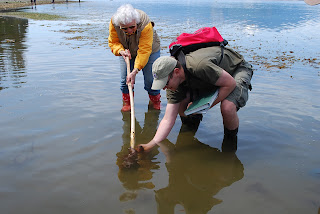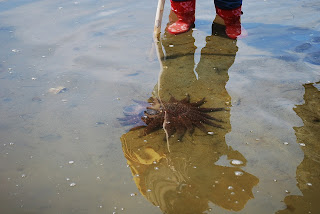“In the end we will conserve only what we love.
We will love only what we understand.
We will understand only what we are taught.”
Baba Dioum
It was one of those days that we, in the Pacific Northwest, spend our winters dreaming of - a bright, clear, sunny day. Overhead, brilliant blue sky with a few white wispy clouds whispered that spring had finally arrived. In the distance, the still snow-covered peaks of the Olympic Mountains formed a spectacular backdrop for heavily-treed lower hills on the far side of the mighty Hood Canal. Before us stretched the shoreline - and the reason we had come.
Growing up and spending my young adult years inland, I never imagined living near, or spending much time on, an ocean beach. Yet here I was, not far from home on one of many excursions along the myriad shorelines of the Puget Sound area. On this day, our group of volunteer beach naturalists had come to Scenic Beach State Park to refresh our knowledge and sharpen our skills for the summer ahead. Much of our time and effort is spent on local beaches helping others to learn about and appreciate the near shore habitats and their plants and animals.
It's difficult to explain how much joy and satisfaction can come from spending time with others who love the natural world, enjoy continually learning, and relish mucking about in rocks, mud, and water seeking creatures to observe and identify. Our goal, ultimately, is to inspire others to become more knowledgeable and thus respect and help to preserve these precious resources.
There is a part of me that has never grown up which I hold on to with all that's in me. Children mostly view the world through fresh, unsullied eyes. For them it is a vast place, full of interesting things - many of which they as yet know nothing about. Turn them loose on a beach of any kind and I can just about guarantee what they will do; I do many of those same things myself.
Observing the surroundings, they look for something to DO. Depending on the type of beach, time of year, weather, age and personality of the child, and whether or not they've been there before, they - each in their own individual way - begin to explore and become acquainted with this particular place and time.
Pointing, poking, prying, digging, chasing, grabbing, wading, splashing, and kicking, they wander their way through the maze of the known and unknown, often losing track of time. I totally understand...
To nurture the child within all of us, I find it interesting to approach a beach exploration aimed at the most basic levels of observation, curiosity and discovery. It is best to use all of one's senses: hearing, seeing, smelling, touching, and sometimes even tasting.
RESPECT is paramount. Usually, we humans are the noisiest and it's hard to listen when you're making noise. But does that really matter; can any of the animals on the beach hear us?
Well, ears or not, they can feel the vibrations of our noise.
When we are quiet, talking in hushed tones or not at all, we hear and see better.
If we close our eyes and listen, it's surprising what can be heard - the waves lap the shore, the seagulls squawk, and the clams squirt. If you turn over a rock, you can often hear the critters that are hiding under it as they splash and skittle for cover.
Can you hear that teeny tiny crab -
or the splash of that Gunnel?
Learning about nature requires excellent observation skills. Here are two shells we found. Obviously, they were both made by a snail, but what lives in them now?
Only one way to find out...
A Hermit Crab has moved into the shell on the right; a snail still occupies the other one, as its "trap-door" (operculum) is clearly visible. This flat piece of shell, which the snail can pull shut, serves to both protect its soft body and hold in moisture if it is left high and dry with the ebbing tide.
Animals that live in the tide zone need some way to withstand the drying effects of being uncovered during low tides. To survive, they need to be able hide under rocks and seaweed, burrow down into the wet sand, or be equipped in some way to retain water.
Snails are among the best-equipped.
They begin life, as many ocean invertebrates do, as tiny creatures that swim and bear no resemblance whatsoever to the adults of their species. As they mature, they are able to take calcium out of the water to form a shell, adding on to it as they grow larger to accommodate their soft bodies.
The Moon Snail, with its huge, fleshy foot and shell up to four or five inches across, is the largest in our area. By taking in sea water, it can enlarge its foot up to 4 times the size of its shell! It lives in sandy or muddy areas and if it dies or is killed, the large, white, round shell is easy to spot.
The living snail is not easily seen; it half-buries itself and plows through the sand "undercover". The egg cases are easy to spot, once you know what they are. The snail produces a glue-like mucus which it uses, along with grains of sand, to form a thin, tube-like structure around its entire body (foot and shell). Laying its eggs inside of this sand collar, it digs down into the sand and ducks under, leaving the collar with its precious cargo to the tides.
When conditions are right, the tiny snails hatch and take their place among the plankton until they are large enough to begin their shells. Millions hatch, but few survive to become adults.
Those that do, have a unique way to dine. As they plow through the sand, they search for clams. Finding one, they use their extremely rough tongue (radula) to literally lick their way through the shell to reach the succulent meal inside. The beach becomes strewn with the evidence of their prowess.
The beach is a magical place - when we learn the what, how, and why of the incredible things that live there, we gain a much greater understanding of just what this world would be missing if they were not here.
And God said, "Let the waters bring forth swarms of living creatures... So God created the great sea monsters and every living creature that moves, of every kind, with which the waters swarm... And God saw that it was good. God blessed them, saying, "Be fruitful and multiply and fill the waters in the seas..."
For more posts about Incredible Sealife, click below:

























I learned something! I have never seen a "naked" snail before or really understood how they got their shells. What a neat thing you get to do!
ReplyDeleteIt's weird, because after I read this, I was doing research on a product that we picked up out of New Mexico, calcium carbonate, and I found out that it is all over the place, even seawater because it's an ingredient animals use to make their shells. I love it when facts that I didn't even know existed come together!
What a great post! I'm going to tell me fellow Harbor WildWatchers that they should check it out.
ReplyDelete